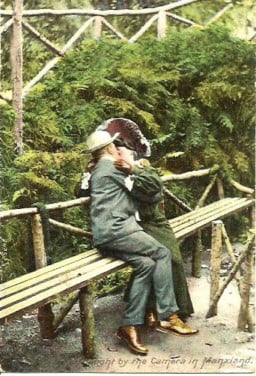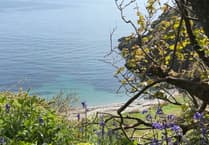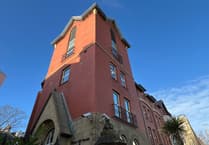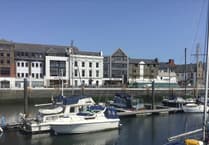In this latest contribution to the Buildings at Risk series of articles, Simon Artymiuk delves into the fascinating links between the island and Switzerland:
In recent months we have seen Isle of Man Transport officials travelling to Switzerland to seek out new braking systems for Snaefell trams, and ’Paradise Papers’ journalists and broadcasters trying to draw parallels between the Manx finance industry and the secretive world of Swiss banks.
There have even been timely falls of snow on the Manx hills - though not quite the 6ft deep kind that marooned 13,000 people in the traffic-free Swiss town of Zermatt, in Canton Valais, this month.
There are parallels which could be drawn between the Isle of Man and Switzerland, such as comparing the annual open-air meeting of Tynwald with the ’Landsgemeinde’ open-air parliaments still held each year in the Swiss cantons of Glarus and Appenzeller Innerrhoden - though those are held on wooden staging in town squares, with the electorate actually able to vote on proposed laws with a show of hands or, for a few men, upraised swords.
By contrast, those two cantons were also among the most recent places in Europe to allow women a vote (in 1971 and 1991 respectively), rather than being the first as was the case of the Isle of Man (1881).
Whatever the parallels, for a number of decades in the late 19th and early 20th centuries there was actually an area of the island known as ’the Manx Switzerland’ - and it wasn’t the upmarket group of properties known as ’Little Switzerland’ in Douglas, or even Switzerland Terrace and the Edelweiss Hotel directly below at promenade level.
Instead it was the name applied by wagonette and charabanc tour promoters, tour guide writers and railway companies to Sulby Glen at the height of the island’s ’visitor industry’ boom.
Interestingly this boom began during the 1860s, at the time of Governor Henry Loch’s promotion of greater democracy and self-sufficiency for the island - and it was in the very same decade that Swiss tourism for ’the masses’ was invented thanks to Derbyshire tea-totaller Thomas Cook running his first tour for British Victorian middle class customers to Switzerland in 1863 using the first railways to reach the country.In the latter half of the 19th century both the little crown dependency in the Irish Sea and the fiercely independent republic in the heart of the Alps saw visitors from industrialised Britain flooding in with their cash to revolutionise their up till then subsistence rural economies and transform their towns and villages with new hotels, railways and tourist facilities.
It was even 19th century British adventurers who were the first to scale many of the highest Swiss peaks.
Lucy Walker
As early as 1871 Lucy Walker, raised in Liverpool, became the first woman to reach the 14,692ft summit of that most ’Toblerone profile’ of mountains, the Matterhorn. Hearing of such feats other, less adventurous Brits wanted to get a bit of - gentler - mountain-climbing action too.
Diccon Brewes, a British travel writer now resident in Switzerland, has written of the era in his recent book Slow Train to Switzerland: ’While [in the early 19th century] writers like Byron, Turner, Dickens and Wordsworth all made lengthy and inspirational visits to Switzerland, such a trip was beyond the aspirations of most British people, simply because it was too expensive.
’That all changed in 1863, thanks to the British middle class and their appetite for adventureâ?¦ their peaceful invasion provided the financial and social means for turning rags into riches. Tourism made Switzerland into the Cinderella of Europeâ?¦ Hotels were built, souvenirs created and railways raced up mountains. Without the British Switzerland might never have developed into one of the world’s richest countries’.
Of course, Alpine tourism was still the preserve of the wealthier British middle class - those lower down the social scale could read the poems and travelogues, view the paintings, etchings and photos and then head to somewhere closer to home with mountains, gushing steams and narrow, rocky valleys that gave them an idea of what Switzerland might be like - which is where the glen and mountain scenery in places like the Isle of Man came in.
The earliest example of a Manx glen being given an Alpine ’look’ was at Glen Helen, which, perhaps surprisingly for us today, was one of the most visited glens in the Victorian and Edwardian eras.
In 1874 Jenkinsons Guide told visitors: ’It is a pleasant drive through the narrow, secluded glen, but there is nothing of special interest until the beautiful miniature suspension bridge and Swiss Cottage are reached. Here the setting is remarkably beautiful, hills covered with foliage rise on every hand, and the crystal stream winds pleasantly at their feet.
’The suspension bridge is a very pretty object. It spans the river and leads to the slate quarries, which were gained five years ago, and are now extensively worked. These quarries and also the lovely Swiss-like cottage and grounds around, belong to Mr R Bell, a Glasgow merchant. The slate is a deep blue colour... the Kirk Braddan new church and other important buildings are covered with it, and occasionally there are consignments to Glasgow and other places...
’The Swiss cottage was built about 20 years ago, as a private residence, by a Mr Marsden of Liverpool.
It stands on a small rivulet, in which fish may occasionally be caught by holding a line out of one of the windows.’
John Marsden
John A Marsden was a brush manufacturer from Liscard in Cheshire - though why he renamed Glen Rhenass (meaning either ’Waterfall ridge’ or ’Divided waterfall’) Glen Helen is unclear, as it would appear that a story that he named it after his daughter is not true, as there is no record of a Helen in his family.
Whatever the reason, it was Marsden who had the walks laid out around the glen and who is credited for planting thousands of trees along it - Jenkins Guide says a million, which must be an exaggeration, though he adds the details that Marsden received a premium from the Woods and Forests Department in England to do so and that the species of tree included scots fir, larch, sycamore, ash, oak, hazel and chestnut.
The writer of the guide also adds the important detail that at that time there was a general noticeable lack of trees in the island and so he hoped other landowners would follow this lead ’not only for its scenic effects, but also as a commercial speculation’ and to ’beautify other glens, so as to vie with this most lovely spot’.
It is a message worth noting at this time when tree diseases like larch and ash dieback are taking their toll in the island - plans should be made to replace those which are lost in the glens.
After Marsden’s death the glen had various owners but by the 1870s was being run by the Glen Helen Hotel and Estate Company and laid out as pleasure grounds, with new bridges, summerhouses and rustic seats, with paths and bridges also built around and over the Rhenass Falls.
A large chalet-style ’Swiss building’ with thatched roof was built near the entrance to the glen, according to Peter Kelly built in 1876 and designed by James Cowle, and part of the agenda was to provide tee-total entertainment inspired by Congregational church leanings of the owners.
Visitors made their way to the glen by wagonettes either direct from Douglas or from St John’s station, which by 1879 was on both the Isle of Man and Manx Northern Railways.
grounds
The grounds had ornamental shubberies, aviaries, a monkey house and even live seals in the river. An old sawmill shelter was made into a bowling alley.
These facilities continued to be popular right up until the 1950s - and it is interesting that Thomas the Tank Engine author the Rev W Awdry, having sited his train characters on a fictional island of Sodor between the Isle of Man and the Lake District after visiting Ellan Vannin in 1950, named one of his engine characters Rheneas, a form of Rhenass. At one time there had been a plan to build a branch of the Isle of Man Railway to the falls but it never happened.
In 1958 the Forestry, Mines and Lands Board purchased Glen Helen and Pleasure Grounds for £4,300.
It was the eighth glen to be purchased for the Manx nation and included the Swiss chalet restaurant, playground and buildings but not the pub and ballroom. A house at the entrance to the glen was eventually purchased and used as a restaurant seating 300 people. Demolition of the old hotel and conversion of the site into a carpark in the late 1960s had unexpected consequences 20 years later when a lorry driver parked his vehicle to spend a penny and found the ground opening up around him. The whole carpark fell into the old hotel basement soon after. By that time, too, the original Swiss chalet had burnt down in 1983 (the same year as the Tholt-y-Will chalet hotel). The replacement built in 1984 has a convincing Swiss chalet appearance and won an award for being a fitting replacement for the building that had been lost.
Sadly now things are very different. The Swiss House Restaurant refurbished and reopened to much fanfare in 2012 has not been open on a regular basis since the end of 2015, with difficulty of recruiting staff at one time cited as a reason. Meanwhile the nearby pub has been bought by a glamping company which has branded the building a ’white elephant’ and wants to demolish it and replace it with glamping pods and a single-storey visitor centre.
There is therefore a danger that the site’s Alpine style charm may be lost - but surely more effective promotion of the glen’s natural beauty to visitors would have drawn more customers to keep the catering businesses going?


.png?width=209&height=140&crop=209:145,smart&quality=75)


Comments
This article has no comments yet. Be the first to leave a comment.